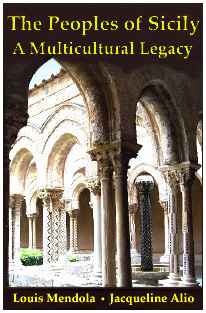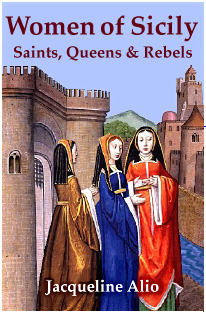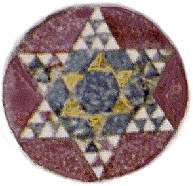...Best of Sicily presents... Best of Sicily Magazine. ... Dedicated to Sicilian art, culture, history, people, places and all things Sicilian. |
by Jacqueline Alio | ||||||
Magazine Index Best of Sicily Arts & Culture Fashion Food & Wine History & Society About Us Travel Faqs Contact Map of Sicily
|
The infamous Spanish edict of 1492 brought to an end the Jewish influence in Sicily. It outlawed the practice of the Jewish religion, and though a number of Jews left Sicily the greater number (like the conversos of Spain) converted to Catholicism and stayed. By the 1520s, acts of baptism and marriage in Sicilian churches near formerly Jewish communities listed a number of families bearing surnames such as de Simone (son of Simon), Siino (Sion) and Mosé (Moses), or Nero or Porpura (for the colours of the fabrics they dyed), and baptismal names such as Isacco, Beniamino, Abramo, Iasué and Davide, formerly rare among Sicilian Christians. The simplest response to the question "Where are Sicily's Jews?" is that, like the island's Byzantine Greeks, Catholic Normans and Muslim Arabs, "they are us." (The subject of Jewish genealogy in Sicily is discussed elsewhere.) Like the Albanian refugees who founded several towns late in the fifteenth century, the Sicilian Jews never constituted a dominant or colonising class, but their contribution to the fabric (literally) of Sicilian society was important. Many Sicilian communities had Jewish populations, and many Jews were involved in fabric dying and (less frequently) weaving. By the time of the edict, Sicily was essentially Roman Catholic. Except for a few Albanian Orthodox churches. It had been a few centuries since the Muslim Arabs and Byzantine Greeks had amalgamated to form a fairly homogeneous Sicilian population. In 1492 the Jewish Sicilians were a small but important part of the island's population, as much as six percent by some estimates. They were hardly "outsiders" in any conventional sense. The first Jews to arrive in Sicily probably settled as traders in Syracuse during the final centuries of the ancient Greek era. The Romans brought some Jews to Sicily as slaves or poorly-paid servants, though it appears that only a minority arrived under such conditions. By the time the Arabs arrived there were flourishing Jewish communities in Messina, Panormos (Palermo), Syracuse, Mazara and elsewhere. The Normans were tolerant and even protective of the Jewish population, and the same might be said of the Swabians. Indeed, the Jews of Sicily experienced little overt antagonism from their fellow islanders until the fourteenth century. The Spanish and Sicilian Christians certainly understood the differences between Muslims and Jews, but both were Semitic peoples whose way of life (at least superficially) seemed quite similar. We should consider that in Norman times even many Christian women wore veils in public. Just as Palestinian Jews and Palestinian Muslims are, after all, Palestinians, Sicily's Muslims, Jews and Christians were, as recently as 1200, fairly similar socially and culturally - even if they kept different sabbaths (Friday, Saturday and Sunday respectively). It is often (and conveniently) overlooked, but Judaism, with its monotheism and moral code, forms the framework of subsequent Western faiths; if there had been no Judaism there would have been no Christianity or Islam - at least not in the forms in which they actually developed. The infamous edict of 1492 was issued in an atmosphere of zeal in a time when Catholicism's influences (including the Inquisition) had displaced those of the tolerant twelfth century. The Moors had finally been defeated in Spain, and the Jews were a convenient target. Easy prey, it could be said. Christianised Jews were allegedly the focus of a riot in Palermo in 1516, and even if the story is untrue it proves that Sicilians descended from Jews were still identified as such a generation after the infamous edict. It appears that by 1492 the Jews of Palermo constituted the largest Jewish community in Sicily, followed by that of Siracusa, whose mikveh (Europe's oldest Jewish ritual bath) is preserved. Much of our knowledge of Mediterranean Jews, including those of Sicily, in the twelfth century comes from Benjamin of Tudela, a Spaniard and comtemporary of Abdulla al Idrisi. In addition to visiting Sicily, Benjamin also described many Gentile groups, and mentioned China. He estimated that there were 200 Jewish families in Messina in the 1170s. That Frederick II employed Jews at court to translate Greek and Arabic works implies a high level of literacy among Jewish Sicilians. In the early 1060s Sicily's Jews often made common cause with the Arabs against the Normans, as at the Battle of Messina and subsequent compaigns in the Nebrodi Mountains of northeastern Sicily. There were occasional expulsions for political reasons, but the communities survived until 1493, when the final effects of the edict were applied. Estimates vary widely, but in the early 1490s there may have been as many as 35,000 Jews in Sicily. Of the Jews who then departed for Rome, Ancona, Venice, Malta or elsewhere, some adopted surnames such as Palermo or Messina in reference to their city of birth - though this is not to imply that all Italians bearing such surnames are descended patrilineally from Jewish forebears. Few traces of Sicily's Jewish heritage remain beyond a handful of inscriptions and small structures scattered around the island - though there is much documentary evidence. Judaic law constituted one of the four civil codes imposed by Robert Hauteville and his brother Roger, the others being "Latin" (Catholic), Greek (Orthodox) and Shari'a (Islamic), even if their enlightened, if complex, policy of "ethnic law" did not survive the Norman era. It is believed, however, that certain localised Catholic religious traditions may be based on Jewish ones. Most Sicilian Jews were involved in craft or trade but at least a few lended money. Frederick II made usury a crime for most private citizens but Jews could lend money at up to ten percent interest. This implies that during the thirteenth century Jewish Sicilians, though very rarely the holders of feudal privileges - as barons or knights - enjoyed the special fiscal trust of the authorities. (A few, however, were actually ennobled through feudal land purchase in later centuries.) The cuisine favored by Sicily's medieval Jews seems to have been similar to Arab cuisine. (The dearth of medieval Sicilian pork recipes may reflect the Muslim and Jewish proscriptions on its consumption.) There exists a popular (though unproven) theory that the Italian dish now known as pizza was invented by Jews in Sicily or around Naples. The traditional Sicilian pizza is sfincione, topped with tomatoes, onions and anchovies (the tomatoes are an American ingredient unknown in Italy in the Middle Ages). If Jewish communities survived in other parts of Italy, the cruel anti-Semitic laws promulgated by little King Victor Emmanuel III and his cohort Benito Mussolini had little effect in Sicily, where Abraham's faith had long ceased to inspire. About the Author: Historian Jacqueline Alio wrote Women of Sicily - Saints, Queens & Rebels and co-authored The Peoples of Sicily - A Multicultural Legacy. | |||||
Top of Page |



 In the Middle Ages the term "Jew" referred not simply to those whose religion was Judaism but to those descended from Jews whose origin was Semitic and rooted in the Middle East --in other words, the ancient Hebrews and Israelites. Like early medieval Islam (initially identified closely with Arabs), Judaism was linked to a certain people, and the Jews of Sicily may be said to have shared cultural similarities with the Sephardim (of Spain) and the Mizrahim of northern Africa and the Middle East. In certain quarters (Russia in particular) recent genetic testing seems to indicate that modern European Jews are closely related to the larger national populations of which they are a part. Whatever the case, Sicily's Jews were in most respects a distinct ethnic group in the Middle Ages, although their vernacular Semitic language, as spoken in medieval Sicily, was more similar to Arabic than Yiddish is to German.
In the Middle Ages the term "Jew" referred not simply to those whose religion was Judaism but to those descended from Jews whose origin was Semitic and rooted in the Middle East --in other words, the ancient Hebrews and Israelites. Like early medieval Islam (initially identified closely with Arabs), Judaism was linked to a certain people, and the Jews of Sicily may be said to have shared cultural similarities with the Sephardim (of Spain) and the Mizrahim of northern Africa and the Middle East. In certain quarters (Russia in particular) recent genetic testing seems to indicate that modern European Jews are closely related to the larger national populations of which they are a part. Whatever the case, Sicily's Jews were in most respects a distinct ethnic group in the Middle Ages, although their vernacular Semitic language, as spoken in medieval Sicily, was more similar to Arabic than Yiddish is to German.